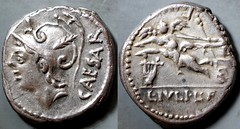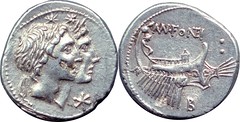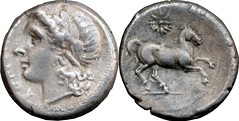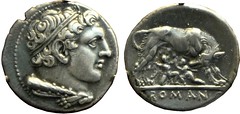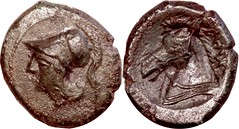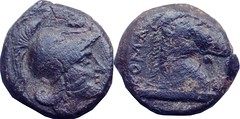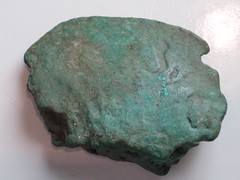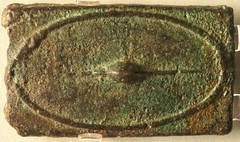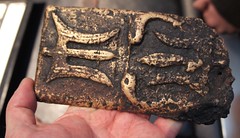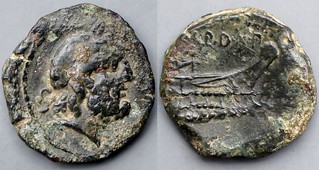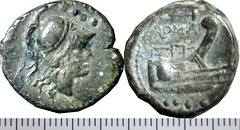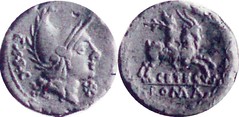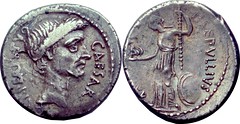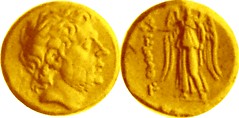Surveys of Numismatic Research The Roman Republic 1966-71 and 1972-77 by MH Crawford
 |
Links to Surveys, The Roman Republic, 1966-1977; Notes to Edinburgh
Introduction: Surveys, The Roman Republic, 1966-1977; Notes to Edinburgh
A Survey of Numismatic Research 1972-1977, The Roman Republic, MH Crawford
A Survey of Numismatic Research 1966-1971, The Roman Republic, MH Crawford- Major Developments
- Chronology
- Technical matters
- Types
- Units of reckoning
- Artistic considerations
- Imitative issues
- For future exploration
Notes to the Edinburgh Collection, by Michael H. Crawford
A Survey of Numismatic Research 2002-2007, The Roman Republic, by Bernhard Woytek
Surveys, The Roman Republic, 1966-1977; Notes to Edinburgh
Introduction: Surveys, The Roman Republic, 1966-1977; Notes to Edinburgh
The three pieces, here republished with the permission of Michael H. Crawford, are not so easily accessible, and in the case of 'Notes to Edinburgh' can only be found with great difficulty, Michael Crawford's catalogue of the Edinburgh collection being a rare volume found in few libraries. Despite the dates on the two Surveys, both post-date the writing of his Roman Republican Coinage (RRC). When the New York and Washington conference was held in 1973, for which the 1966-71 Survey was prepared, RRC was already in preparation for publication and his commentary was made in the context of an already-published RRC, and suggests areas for future exploration. The 1972-77 Survey for the 1979 Berne conference includes Michael Crawford's responses to the various reviews of RRC; many of the other articles cited in that survey were prepared before RRC's 1974 publication (actually available in 1975) thus benefit from reflections in that light. Four amongst many possible examples illustrate the still-useful contents of these Surveys; in 1972-77: a reprise on the estimation issue size; a reconsideration of the didrachm coin arrangement; and in 1966-71: a commentary on the recording of coin hoards; and on excavation evidence for pre-coinage money bars. His notes in 'Roman Republican Coins in the collection of the Royal Scottish Museum Edinburgh' present updated views on coin types and their historical references. All three pieces precede the 1985 publication of 'Coinage and Money under the Roman Republic: Italy and the Mediterranean Economy', his next major numismatic work. Thus in aggregate these can be considered the post-script, the opportunity to respond on RRC reviews, his later thoughts on some RRC subjects, and suggestions for the future.
The original Surveys did not of course include photographs, and the notes to Edinburgh included photographs of that collection. Considering this web-page may be read by many amateurs without RRC (or the Edinburgh catalogue) to hand, I have included below each paragraph, pictures of examples of the coins discussed. In the case of Edinburgh of course these are not the actual pieces discussed, but the examples of the same type.
A Survey of Numismatic Research 1972-1977, The Roman Republic, by Michael H. Crawford
Prepared in advance of the International Numismatic Congress at Berne, 1979
Reproduced, 2011, with permission of the author. © Michael H. Crawford, INC and IAPN.
Survey 1972-77: The Roman Republic - Introduction
My last research project on the coinage of the Roman Republic, not altogether satisfactory because of other current preoccupations, appeared in 1973. Also in 1973, Moneta by H. Zehnacker appeared, reviewed by myself in JRS 1975, p.177, and in 1974 (actually 1975) my Roman Republican Coinage. My aim was to present the whole of that coinage, considered solely from the point of view of the issuing authority or authorities, in such a way that would illuminate areas of Roman Republican history on which neither other sources nor analogies with other societies threw any light. Coinage, Money and the Economy under the Roman Republic (London, Methuen forthcoming) deals with the monetary and economic context within which the coinage of the Republic came into being and rose to dominance, with the provincial and local issues of the Republic and with the interaction between the monetary history and the changing economy of the Mediterranean in the last three centuries B.C.
Meanwhile, much new hoard evidence has appeared, some of it pleasingly falling in periods where I was forced to make do with very inadequate documentation, and critical discussion has deepened our understanding of some important problems of the coinage of the Roman Republic.1
| (1) This survey should be read in conjunction with 'Addenda to Roman Republican Coin Hoards' to appear in Coin Hoards 1979, and Roman Republican Coins in the Royal Scottish Museum, forthcoming; I there deal with new work on individual issues, including the list of detailed comments of HERSH, C.A., NC 1977, pp.27-34, a list which contains errors (the desired discussion of RRC 17/1 appears in RRC, p.45; RRC 344/2a is also known from a specimen in Illinois from different dies to those of the specimen in Berlin) and corrigenda rendered necessary by the absence of response to my enquiries. |
I do not further discuss:
|
Survey 1972-77: I - Size of Issues
The chapter on the size of Republican issues, much of which seemed to me the explicit articulation and laborious application to the coinage of the Republic of principles familiar notably to Greek numismatists, has attracted a surprising amount of attention. My chief innovation seemed to me to be an attempt simply to shift attention away from degrees of rarity towards degrees of commonness. The failure to distinguish rare sub-divisions of an issue was quite deliberate, since it was and is no part of my purpose to help collectors discover with delight their possession of rarities: whence the use of the standard notation <, apparently unknown to one reviewer.
In retrospect, I should have cited explicitly the publication of the Lohe hoard by B. Thordeman in NC 1948, p.188 which showed an almost perfect correlation between the numbers of coins of each year in the hoard and the numbers known from mint records to have been issued each year.
This remarkable hoard was very much in my mind when I wrote Roman Republican Coinage, as indeed it is in the mind of anyone well-informed in the field of quantitative studies of ancient coinages; it was not in my mind when I doubted in 1965, after studying a single issue, whether 'calculations of the size of issues either from the number of surviving specimens or from the number of dies used are very reliable'. Study later of a large number of issues (but still not large enough, see below) of the coinage of the Republic, which circulated over a very wide area without interruption for a very long time, and knowledge of such phenomena as the Lohe hoard made it likely that my early opinion was a piece of youthful misjudgment, though it has been endorsed by FRIER.2 The onus of proof in fact clearly lies on those who wish to maintain such a view.
| (2) FRIER, in Phoenix 1976, p.381. The review in places misrepresents the arguments and procedures of RRC (especially p.696, para.1) and suggests that cautiously to draw attention to two sets of independent phenomena, whether a rise in the cost of a legion at some time and the rise in the size of issues in the age of C. Gracchus or the volume of state expenditure and an estimate of the volume of coinage, is to argue in a circle; the substantive point is in any case superseded by the considerations advanced in the text. |
It is in principle easy to establish the relative commonness or rarity of a particular issue, something which has been done up to a point for a century or more, whether by Mommsen, who listed the occurrences in hoards of Roman Republican issues down to 49 BC, or by Cohen and Babelon, who offered estimated modern values, or by the editors of RIC ii onwards, who offered estimated degrees of rarity.2 Given that only for a few issues is it knowable how large they were originally, two avenues are then open, to establish for as large a sample of issues as possible the relationship between original size and surviving specimens or to establish the number of dies used and the number of coins struck per die. The first avenue is in theory available for certain rare Greek and Roman issues, but certainly not for the bulk of the Roman coinage, since it is clear from the amount of material which passes through the market that there is an unknowable, but large, number of pieces of common issues in inaccessible private, and for that matter 'public', collections; whence the notion of counting dies for a sample of issues and extrapolating to other issues, in order to establish the number of dies used overall.
| (3) Compare the approach of EHRENKREUZ, A.S., Studies G.C. Cameron, Ann Arbor, 1976, p.207, 'Numismatics re-monetised'. Note also the calculations of METCALF, W.E., ANSMusN, 1977 pp.93-94, on the coinage of Trebonianus Gallus and Volusian; my review of SARVAS, P., in NC 1979. |
At this point I must apologise for a serious error in drafting which resulted in material being removed from the notes to RRC Table L and not being incorporated on p.641, which should have read: [AM the cited correction is preceded by 'A number of Republican moneyers were considerate enough to use for denarii and quinarii numbered or lettered sequences of dies; and it is possible to observe without undue difficulty that in some cases a number or letter never has more than one die. ... It is therefore possible to compare, for the issues under discussion, the number of dies from which specimens survive to be observed, with a theoretical maximum.] It emerges in the case of issues whose dies are counted exhaustively that the first figure is consistently some 90% of the second figure'.4 It was obvious to me and explicitly admitted on p.xiv that in most cases my counts of dies were not absolutely complete; it followed that estimates of dies were also likely to be slightly on the low side.5
| (4) Note also that in RRC Table LVIII the volume of coinage for 79 BC should be 500,000 denarii less than shown. [p.704: 19.5 million, presumably should be 19 million] |
| (5) So already 'Les Dévaluations à Rome', Rome 1978, p.51. |
With the proviso, then, that operating necessarily with an incomplete record of what survives, I tended to understate and therefore to underestimate the number of dies used, it remains to observe whether the estimates of numbers of dies used are of the right order of magnitude.
I tabulate here some estimated figures of mine, together with the actual numbers known to HERSH (I ignore issues with less than 30 estimated dies).6
| (6) NC 1977, p.35. |
| Issue | Estimated (Crawford) | Actual Known (Hersh) |
| C. Fonteius RRC 290 (obv.) | 142 | 126 |
| L. Saturninus RRC 317/3 (rev.) | 462 | 491 |
| P. Sabinus RRC 331 (rev. + obv.) | 100 | 77 |
| T. Cloulius RRC 332 (obv.) | 225 | 277 |
| C. Norbanus RRC 357/1b (obv.) | 156 | 183 |
| Ti. Claudius Ti.f.Ap.n. RRC 383 (rev.) | 182 | 232 |
| P. Satrienus RRC 388 (obv.) | 102 | 93 |
| L. Lucretius Trio RRC 390/2 (obv.) | 80 | 63 |
| L. Cossutius C.f. Sabula RRC 395 (rev.) | 31 | 38 |
| C. Caldus RRC 318/1a (rev.) | 90 | 167 |
| C. Caldus RRC 318/1b (rev.) | 119 | 157 |
| L. Iulius L.f. Caesar RRC 320 (rev. + obv.) | 92 | 164 |
| P. Crepusius C.Limetan L.Censorin RRC 360 (rev.) | 62 | 99 |
| L. Farsuleius Mensor RRC 392/1b (rev.) | 40 | 57 |
[AM: Below shown some of these control-numbered issues; others are illustrated elsewhere on this page]
I ignore the issues of L.C. Memies L.f. where a very large proportion of the control marks are uncountable and of C. Naevius Balbus, where the lettered and numbered reverse dies are only a part of the total.
Within this sample, attested dies turn out to fall within about 25% of the estimated figure in nine cases [RRC 290, 317, 331, 332, 357, 383, 388, 390, 395] (27% in the case of Ti.Claudius), much further away in five cases [RRC 318, 320, 360, 392]. It is to be noted that in the nine cases tabulated, the estimated figure is not consistently too high or too low, but falls on either side of the actual figure.
In addition, T. Hackens informs me that his estimate of the obverse dues for the first issue of M. Volteius is 70, H-D. Schultz that he has counted 49 obverse dies for the issue of P. Crassus M.f. (estimate 63). A. Burnett tells me that his counts of dies for the didrachm coinage broadly confirm my estimates, about which I was particularly pessimistic. R. Grassby's count of the dies of L. Piso L.f.L.n. Frugi, which I am preparing for publication, is similarly confirmatory. In particular, it is clear that the ratio of dies to specimens counted with which I operated for the period 82 BC to 58BC is not, on average, much too low, despite BUTTREY'S scepticism.7
| (7) BUTTREY, T.V., Classical World October 1977, p.152; his calculation of the relative sizes of the issues of P. Crepusius and Ti. Claudius is vitiated by the fact that the numbered dies of the latter run to 165 + 129. |
It is also worth noting that the two issues where the estimate is really badly out, C. Caldus and L. Iulius L.f. Caesar, fall in a period where I had already drawn attention to anomolous survival rates, in the case of the issues of Mn. Fonteius and C. Fabius C.f. We are clearly dealing with a period for which the production and survival of coinage deserves further study.
It is in any case obvious that the closer an issue for which the number of dies is estimated is to an issue for which the number of dies is counted, the closer the estimate is likely to be to the truth.8 Ideally, instead of five periods, each with its average ratio of dies to specimens in a hoard sample, one would like to operate with fifteen or so; with this in mind, it is worth drawing attention to BUTTREY'S new count of the dies of Crepusius;9 MATTINGLY has announced his intention of counting the dies for the Narbo issue.10 It remains true, of course, as already remarked, that in some cases the survival pattern even of contiguous issues may be rather different.
| (8) So RRC, p.672, endorsed by T.V. Buttrey, l.c. |
| (9) BUTTREY, T.V., 'The Denarii of P. Crepusius and Roman Republican Mint Organization', ANSMusN 1976, p.67; I do not agree that every die once cut is in principle now knowable. |
| (10) MATTINGLY, H.B., 'Coinage and the Roman State', NC 1977 p.214. I have seen the bulk of the Berchidda hoard in Cagliari and Mattingly's doubts over the accuracy of the original publication are misplaced. |
The problem of the average number of coins struck by an obverse die of the Roman Republic remains intractable. I operated with one small issue for which we probably know the amount of bullion and the number of dies used [AM, Mars/Eagle gold with staff, pentagram and spearhead: RRC p.694 "some 1000 pounds of gold at least were used; from this 96,000 gold pieces (or more) could be struck. Since 4 obverse dies were apparently used, each due struck on average at least c. 24,000 pieces" RRC p.34 "I list the generals who received gold with tentative suggestions as to what they did with it ... M Marcellus in Etruria (500 lbs): part struck as issue with pentagram, part passed on to C. Calpurnius Piso and struck as issue with staff. Q. Fabius Maximus in S. Italy (500 lbs): struck as issue with spearhead"] and the issue of C. Annius, for which we probably know the number of troops paid and the number of dies used.
There is one further issue for which it would be worth counting dies, that of L. Cestius and C. Norbanus, if the conjecture of A. Alföldi on its purpose is correct. But unless we know how much a legion cost, this could not help. Despite MATTINGLY'S critique of my view that the total annual cost of a legion in the period between 67 BC and 49BC was 1,500,000 denarii,11 it still seems to me more plausible than any other; I do not for a moment suppose that the grant of men and money to Pompeius in 67 BC was all taken up, but I do suppose that the number of men allowed (24 legions) related to the amount of money involved (36,000,000 denarii) and that the amount of money involved was the figure for one year.12 I also continue to attach some weight to the evidence for the period after the pay rise introduced by Caesar, not discussed by Mattingly. The evidence relating to Pompeius in 52 BC is clearly capable of more than one interpretation, but that relating to Piso in 57 BC is quite explicit and not to be set aside by the argument that special provision was made for him. Nor do I believe that when Ahenobarbus left Rome in 49 BC, the 1,500,000 denarii he had with him was for anything other than the legion which he had with him (whether somewhat under strength or just over strength is immaterial); it was not, in my view, for hypothetical recruits.
| (11) MATTINGLY H.B., NC 1977, pp.206-209 (the suggestion that M. Scaurus and P. Hypsaeus paid for part of their issue in 58 BC, pp.209-214, though interesting, does not seem relevant to the immediate problem). |
| (12) Contra MATTINGLY NC 1977 p.207 note 44 [AM "since the command was potentially for three years, the expense figure doubtless provided for that"] |
However, none of this is probative, any more than the observation (RRC p.671) that if my estimate of the number of dies used for the legionary issue is right and if each die struck about 30,000 coins, then the amount produced provided Antonius with enough for one stipendium [AM a stipendium being one of three annual installments (LacusCurtius); RRC p.671 "864 obverse dies (for RRC 544) would produce about 25,000,000 denarii, enough for only one-third of a year's pay for 23 legions at post-Caesarian rate; for this calculation will work out with any figure, consistently applied, for the total cost of a legion".]
There are two further points which may be made. The figure of 30,000 coins per obverse die on average derives from the suggestion that Annius used about 130 dies in paying out a sum which, given 1,500,000 denarii as the total annual cost of a legion, was over 3,000,000 denarii by a significant but uncertain amount. If it is approximately right, it follows that between 157 BC and Sulla, except for two short periods, the Roman state paid its expenses in new coin; between 62 BC and 50 BC, when the Roman state certainly did not do this, issues are minimal in eight out of the thirteen years, precisely what one would expect with a system of topping up stocks of old coin with new issues, small except in years of extraordinary expenditure. If, as Mattingly suggests, an obverse die struck on average 15,000 denarii or if, to take a probably minimum figure, it struck 10,000 denarii on average, we find the Roman state paying half or a third of its expenses in new coin. I find this odd and certainly something which needs discussion and explanation.
Secondly, starting from a totally different body of evidence, COARELLI has shown that independent argument confirms a general picture derived from the numismatic evidence of regular outlays for the most part on military activity, with large irregular outlays on building activity in and after the Gracchan period (rightly recognised as perhaps the least well documented in the whole of the late Republic);13 BUTTREY is quite wrong to be surprised by such a pattern of expenditure.14
| (13) COARELLI, PBSR 1977, p.1 |
| (14) Buttrey has also forgotten that even the late Republic operated with the ideology and to a large extent the practice of part-time, non-professional soldiers; of course the types of coins paid to soldiers were such as appealed to voters. |
Survey 1972-77: II - Chronology15
| (15) I deal with some of the problems of the early coinage of the Republic in 'Roman Republican coins from archaeological contexts: a check-list' forthcoming in AIIN. |
| AMANDRY, M., RBN 1976, p.59, concludes (following H. Schaefer in RE and RRC, p.37 note 3 and p.602 with note 3, but without acknowledging either) that Pomponius provided no reliable evidence for the date of the creation of the IIIviri a.a.a.f.f. BELLONI, G.G., La data di introduzione del denario, RIN 1976, p.35 simply goes over well-trodden ground once more. |
There has been a dramatic improvement in the quantity of hoard evidence available for the early didrachm coinage, ably discussed by BURNETT (though the argument from the coinage of Locri is very weak); it emerges that the first Roman didrachm, the Mars / Horse's head ROMANO RRC 13/1 issue, was struck either side of 300 BC,16 and that there was the a long gap before any more silver was struck, the Hercules / Wolf and twins RRC 20/1 and the Roma / Victory RRC 22/1 issues both falling after about 270 BC and the Apollo / Apollo (sic) issue [AM i.e. Apollo / Horse didrachm RRC 15/1; Apollo / Apollo being the assumed related RRC 18 Aes Grave] belonging not much earlier; Burnett has gone on to argue that the notorious moment in 269 BC, to which the literary tradition refers, is not the first striking of Roman silver at Rome, but the first use of foreign silver at Rome. But I find it most unlikely that the use of foreign silver on such a scale should have left so little trace in the admittedly fragmentary archaeological record, and hardly believable that Rome, although a state which issues silver coinage, distributed booty in foreign silver. The Hercules / Wolf and twins issue still seems to me to be the first issue at Rome, in 269 BC, the Apollo / Apollo issue to fall immediately before, the Roma / Victory issue to follow in 264 BC.17
| (16) BURNETT, A., The coinage of Rome and Magna Graecia in the late fourth and third centuries BC, SNR 1977 p.92, thus upstaging MATTINGLY, H.B., NC 1977 pp.202-203; Quaderni Ticinesi 1978 p.121; see also note 47 below [Mitchell's dating of the Roma / Victory didrachms] |
| (17) MATTINGLY H.B., NC 1977 pp.201-202, argues that the Eqyptian prototype for the sequence of letters on the Roma / Victory issue of didrachms belongs in 252/251 BC to 242/241 BC (wrongly attributing to me a belief in Svoronos' 'era of Arsinoe'); if this dating of the Eqyptian series is correct, which is by no means certain, we must abandon the notion that it is a prototype at all (so A. Burnett, p.119, persuasively). |
The aes grave is a much more intractable problem; the Dioscuri / Mercury series RRC 14, which is the earliest, need not go with the earliest didrachms, as Burnett rightly remarks; it may fall anywhere down to c.275 BC. It still seems to me, however, that the Dioscurus / Apollo series is subsidiary to the Apollo / Apollo series, not only being rare, but also consisting of the as and semis only, and that the two varieties belong with the Apollo / Horse RRC 15 issue of didrachms, which also consists of two varieties [with eight or sixteen stars].
Nor am I persuaded that the Wheel series is to be dissociated from a didrachm issue because it includes the tressis as the equivalent of the didrachm; in the quadrigatus coins, the quadrigatus and its equivalent, the decussis, and the tenth-quadrigatus and its equivalent, the as, were probably all struck simultaneously. I should still associate the Roma / Roma series of aes grave with the Hercules / Wolf and twins issue of didrachms, the Wheel series with the Roma / Victory issue. But it is unfortunately true that any synchronisation of silver and aes grave contains a large element of uncertainty.18
| (18) ZEHNACKER, H., Moneta p.235, displays a lingering attachment to the notion of contemporary production of certain issues of aes grave; MATTINGLY, H.B., NC 1977 pp.199-201, changes the relative order established by R. Thomsen; a case could be made out but I am not persuaded by this one. |
On the Minerva / Horse's head struck bronzes, I am now persuaded that they probably fall towards the end of the period within which they must fall, 273 to 242 BC, rather than near its beginning.
I should in RRC perhaps have discussed the pottery of the 'Atelier des petites estampilles',19 whose impressed and painted décor uses motifs borrowed from aes grave; the pottery was probably in production between 300 and 250 BC, perhaps most intensively between 285 and 265 BC, a fact which fits well with the dating of the prototypes on the coinage to 280 (perhaps) to 265 BC.
| (19) MOREL, J.P., MEFR 1969 pp.107-108 |
Some clarification unfortunately seems necessary on the subject of aes signatum. This is a modern term, used in a narrow sense to describe the case bronze bars listed in RRC, nos.3-12, and in a wider sense to describe all cast bronze bars. By contrast, when Pliny, following or garbling Timaeus, wrote (Naturalis Historiae xxxiii, 43) 'Servius rex primus signavit aes' he meant that Servius Tullius was the first Roman to strike coins. It has long been known that non-Roman cast bronze bars occur in sixth century BC contexts;20 it is thus, to borrow an expressive phrase from E. Gabba, assolutamente fantastico to suggest21 that the account of Pliny (Timaeus) is confirmed by the recent find from Bitalemi,22 comparable to those from Grammichele.
| (20) Grammichele, BPI 1900 p.276. |
| (21) BREGLIA, L., AIIN 1965-67 p.269; AMPOLO, C., PdelP1974 p.383; PALLOTTINO, M., CRAI 1977 p.229. TORELLI, M., Tre studi di storia etrusca, Dial Arch 1974-75 at pp.23 and 47. |
| (22) Kokalos 1966 p.25; AIIN 1965-67 p.1. ZEHNACKER H., Latomus 1977 p.209 (reviewing RRC), argues that ROMANOM and ROMANO = ROMANORUM, rather than, as I supposed, (aes) Romanum, (nummus) Romanus. Maybe. |
An important article by HARRIS also illuminates the early Roman Coinage;23 he points out that major reforms of the quaestorship at Rome twice fell close to major reforms in the coinage system, with the number of quaestors increased by two in 267 BC, immediately after 269/268BC, and with an additional quaestor being deployed to Sicily and a quaestor being designated to Ostia in 211 BC, when the denarius was created and (in my view) the III viri a.a.a.f.f. were instituted, thus freeing the two quaestors.
| (23) HARRIS, E.M., CQ 1976 p.92. |
The chronology of the last quarter of the second century has also benefited from the access of new evidence.24 The most important is the publication of an overstrike by VILLARONGA,25 of a Carthaginian issue struck in Sicily on an early denarius; further confirmation of 211 BC as a terminus ante quem for the denarius is thus provided. The attempt of STÖCKLI to date the quinarius and sestertius after 197 BC and the denarius even later, in any case unconvincing,26 thus emerges as forlorn; nor is the independent suggestion that the quinarius and the sestertius precede the denarius, and the victoriatus the quinarius and sestertius, any more convincing. Some early issues of the denarius coinage consist of the victoriatus without the denarius or any of its fractions, others display the opposite pattern, some consist of the quinarius (and sometimes the sestertius) but do not include the denarius, others the reverse (Stöckli is unaware that all denarii with H are plated ancient forgeries, RRC p.562); recently discovered hoards have also redressed the balance of representation in favour of the denarius and its fractions and within that complex in favour of the denarius. One such of great importance has become available since the publication of RRC, unfortunately broken up and exported rather than preserved intact in an Italian museum.27
| [for a more recent opinion, see WITSCHONKE, R.W., 'The H denarius rehabilitated' NC 2008 p.141] |
| (24) For 'Contributi introduttivi allo studio della monetazione etrusca' see my Review and Discussion, forthcoming in NC 1980. |
| (25) VILLARONGA, L., Gaceta Numismatica 40 (March 1976), MARCHETTI, P., 'La datation du denier Romain et les fouilles de Morgantina' RBN 1971 p.81, briefly noticed in RRC p.751, argues that the denarius antedates the first revolt of Morgantina in 214/213 BC; but the assertion that Roman coins could only have come to Morgantina before the first revolt ignores the possibility of booty, and the suggestion that Carthage destroyed Morgantina in the course of this revolt involves some very special pleading; nor is the corollary that coins of the Syracusan democracy were overstruck into Roman bronzes of sextantal standard from 214/213 BC onwards very likely; T.V. Buttrey is about to publish a full reconsideration of the Morgantina evidence. |
| FORTELEONI, L., AIIN 1971-72 p.113, on Roman overstrikes of Sardinian bronzes is wrong. I hope in due course to publish a supplementary list of overstrikes to that in RRC. |
| (26) STÖCKLI, W.E., 'Bemerkungen zur Chronologie von Victoriat, Denar, Quinar und Sesterz' JNG 1975 p.73. |
| (27) HERSH, C.A., 'A Tri-denominational Hoard of Early Roman Silver Coins from Sicily' ANSMusN 1976 p.59; 'Notes on the Roman Republican Coinage' NC 1977 p.19. |
This hoard, despite assertions to the contrary, largely confirms the arrangement of the early denarius coinage in RRC, containing as it does examples of most of the groups into which the first period of the denarius coinage is there divided (not, of course, those consisting only of bronze or of the victoriatus and the half-victoriatus). Two of the missing groups, one consisting of the issues with caduceus and knife (RRC 108 and RRC 109 ) and the other of the issues with wreath and AV (RRC 110 and RRC 111 ), are relatively uncommon; the remaining missing group consists of an anonymous issue followed by the issues with crescent and cornucopiae (RRC 53 , RRC 57 and RRC 58 , all with Roma with peaked helmet), probably from a mint at Rome, and its absence from the hoard may be taken to suggest that it belongs after the closing date of the hoard. Such an inference is fragile, since the hoard, which is from Sicily, does include pieces of comparable style struck in Sicily; it also ignores the metrological evidence, which I hope to discuss in detail elsewhere.28 I should now want to argue that RRC 53 and RRC 57-58 do not belong among the very earliest groups of denarii, but that their production nonetheless overlaps with that of the other group assigned in RRC to a mint in Rome.
| (28) See also below, note 31. |
As for the groups of denarii which are represented in the hoard, it is clear that they were struck at a number of different mints in Italy and Sicily and unless one supposes that Rome struck coinage in succession at a variety of mints, the groups must be rearded as broadly contemporary. Some specimens in the hoard are of course somewhat worn, but then so are some specimens of the denarius coinage in the deposits at Morgantina,29 which no-one wishes to date more than a year or two after the start of the denarius coinage. The hoard may be taken as providing a reasonable conspectus of say the first five years of the denarius coinage. Certainly Hersh's sequential arrangement is a jumble, for instance separating the issue with H and the issue with Q (RRC 85 and 86, see plate XVI) and inserting the Sardinian group between the issue with staff and the issue with C (RRC 106 and RRC 107 , see plate XX).30
| (29) Compare ANSMusN 1976, plates IX-X, with AJA 1959, SJÖQVIST, E., 'Morgantina, Hellenistic Medicine Bottles' , figs 19-20. |
| (30) A point allegedly overlooked in RRC (NC 1977 p.24) is actually discussed not ten lines away from a passage quoted by Hersh. [AM: NC 1977 p.24: 'He overlooks the fact that these dupondii (RRC 56/1 and 69/1) are overstruck on early sextantal asses'; RRC p.12: 'All pieces (RRC 56/1 and 69/1) are overstruck on asses of sextantal standard...'] |
Equally one-sided approaches to the origins of the denarius coinage may be found in recent articles by ALFÖLDI and MARCHETTI,31 the former concentrating on literary evidence, the latter on metrological evidence. Alföldi uses Polybius vi,58,5 to argue that denarii (and victoriati) were in existence by 216 BC and that the Campanians borrowed the types of the victoriatus and not vice versa, ignoring the evidence of the Syracuse and other hoards that in 215 BC the quadrigatus was still a long way from replacement by the denarius (he also supposes against Rudi Thomsen's massive demonstration that quadrigatus and denarius circulated together). It is interesting to compare Alföldi's assertion that Zonaras' account of the debasement of the Roman coinage refers to 217 BC or an earlier year, wiht Marchetti's assertion that it dates to 216 BC. The answer of course is that the passage has no precise chronological indication at all. Marchetti is no doubt right to emphasise that the weight standard at the various stages of the reduction of the as were precisely calculated, but wrong to suppose that in every far-flung mint, in the middle of a desperate war, the official weight standard was always maintained. Nor are his absolute dates plausible, 216 BC for the quadrantal standard (why did Capus in 215 BC overstrike nothing except semilibral pieces?), 211 BC for the uncial standard; many second century issues are comfortably above uncia. Few will follow Marchetti and suppose that the denarius was retariffed in 211 BC or that Polybius vi,39,12 uses, without warning, the Rhodian or cistophoric drachma.32
| (31) ALFÖLDI, A., MDAI(R) 1971 pp.51-53, MARCHETTI, P., in Numismatique Antique, Nancy and Louvain, 1975 p.75; and MARCHETTI, P., Les manipulations de la monnaie romaine au cours de la Deuxième Guerre Punique, 8 Cong Num p.339, the former briefly noticed in RRC p.751. Alföldis attempt to make sense of Pliny NH xxxiii,47 is not successful. [AM: Marchetti wrote a later book on the subject, not seen by me: Marchetti P., Histoire économique et monétaire de la deuxième guerre punique, Bruxelles, 1978, 547 p.] |
| (32) MARCHETTI's speculations on the basis of the account in Livy xxxix,7,5 of the partial repayment of an uncertain total are unconvincing. ZEHNACKER, H., Latomus 1977 p.209, expresses doubts about T.V. Buttrey's view of the retarrifing of the denarius, but does not pursue the matter. |
It is of course legitimate to discuss and elucidate one aspect of the evidence for a problem; thus HAFNER shows that the case for regarding the prow on the coinage of Antigonus Doson as providing the model for the Prow series of aes grave is weaker than hitherto supposed, and ZEHNACKER discusses the nummi novi of the Casina (the reference is still in my view perfectly generic);33 but the problems of the early denarius coinage can only be solved by considering all the evidence together, literary, hoard, stylistic, metrological and so on. Any other approach is necessarily flawed.
| (33) HAFNER, G., SNR 1976, 17 (see also FROST, H. and BASCH I., Int. Jour. Naut. Arch. 1975, 201, on rams and prows); ZEHNACKER, J., Mélanges Heurgon, 1035. |
The years between 135 BC and 126 BC have benefited from the discovery of a large hoard, again unfortunately broken up and exported.34 This hoard fills a large gap in the hoard evidence and makes it clear that the system of two workshops functioning in alternate years, hypothesised with great reluctance in RRC, cannot stand; the period still bristles with problems, to which I shall return in the context of a full consideration of all the numismatic and historical evidence.
| (34) HERSH, C.A., NC 1977 pp.24-27 [New Italian Hoard], a summary listing with a provisional chronology which clearly requires modification; thus Hersh rejects the inference to be drawn from the absence of a group of common issues from the Syracuse hoard, but attaches weight to the absence of a rare issue from the Zasiok hoard. |
Interest in the date of the Narbo issue seems to have died down for the time being; I note that the figures in Velleius 1,15,3-5 perhaps strengthen the case for 118 BC, a date which is also defended by SUMNER.35 Caepio's quaestorship seems also finally to have come home to roost in 101-100 BC; the coinage of the 90s and early 80s BC remains problematical, however, with the Lex Papiria at the centre of the complex of problems. RRC attributes the law to C. Papirius Carbo, and him to 92/91 BC, a possibility accepted by G.V. Sumner and rejected by Mattingly,36 Failing new evidence, I fear, non liquet.
| (35) SALMON, E.T., 'The coloniae maritimae', Athenaeum 1963 pp.10-11; SUMNER, G.V., 'Orators in Cicero's Brutus', Toronto and Buffalo, 1973 pp.94-97. |
| (36) SUMNER, G.V., 'Orators in Cicero's Brutus', pp.117-118 (unaware that of the coinage of D. Silanus only the sestertii and the bronze were struck under the Lex Papiria); MATTINGLY, H.B., NC 1977 pp.203-206. |
More interesting is the suggestion of Mattingly that L. Molo and the triumvirate of A. Albinus etc. be moved from ?97 BC and ?96 BC to the late 90s BC, and that some issues traditionally placed before that of Piso and Caepio be moved after him. The first suggestion seems to me very plausible, the latter less so; it involves some very special pleading over the appearance of the issue of Piso and Caepio in the hoards; nor is it likely that L. Saturninus was moneyer in 101 BC rather than 104 BC;37 and where Q. Thermus goes, there goes L. Caesar also; he was consul in 90 BC, so hardly moneyer in the 90s BC.38<.sup>
| (37) SUMNER, G.V., pp.119-121, makes Saturninus quaestor in 104 BC. |
| (38) I list, but do not discuss, the various chronological essays in ALFÖLDI, A., SM 1974 p.37; Chiron 1974 p.207; Mélanges Seston, p.1; SM 1974 p.107; RN 1973 p.99; Chiron 1975 p.165; Chiron 1976 p.143; 'Greece and the eastern Mediterranean in ancient history and prehistory', studies presented to F. Scachermeyr, Berlin, 1977 p.1; none of these articles comes to terms with methods or pieces of evidence universally thought important since the middle of the nineteenth century and I cannot do better than borrow from JRS 1968 p.240, 'Free play for fresh ideas, by all means, but free play means knowing the rules of the game, which are public, not private rules'. |
Survey 1972-77: III - Technical matters
J-C Richard has been so good as to inform me of another Republican die, presumably that of a forger, of the obverse L. Iulius (RRC 323/1); HALLEUX has discussed the early development of brass and the techniques of its manufacture, also the literary sense of oreichalkos as an unspecified valuable metal.39 Zehnacker has discussed brockages in bronze. There has been a proliferation of studies of the Roman pound,40 culminating in statistical proof of the commonsense view enunciated in RRC that it cannot be precisely calculated.41
| (39) HALLEUX, R., BSFN 1977 p.184; Antiquité classique 1973 p.64. See also the article by BUTTREY, T.V. ('Crepusius', note 9 above) for the number of engravers at the mint in the 80s and 70s BC. |
| (40) BSFN 1975 p.734. |
| (41) GUEY, J., RN 1976 p.110. |
Survey 1972-77: IV - Adminstration and control
BURNETT has argued that during the Republic the moneyers were appointed by the consuls each year (by what principle did two consuls often bitterly hostile to each other appoint three moneyers?);42 the hypothesis is excluded by Cicero, de legibus iii, 6, listing moneyers along with (other) elected magistrates (compare the cursus honorum of C. Claudius Pulcher); nor has Burnett considered the IIIviri mensarii, certainly elected and in a way the forerunners of the moneyers.
| (42) BURNETT, A., 'The Authority to Coin in the Late Republic and Early Empire' , NC 1977 p.37. |
Survey 1972-77: V - Units of Reckoning
The account in RRC of the changeover from asses to sestertii as units of reckoning has provoked a long critique by Professor NICOLET, refuted (I hope) in my comments ad loc.43 More important in any case than the rightness or wrongness of this particular theory are two recent attempts, by BIRKS and HONORÉ, to relate the development of Roman Law to monetary phenomena, notably the decline in the intrinsic value of the as between the end of the third and the middle of the second century BC.44
| (43) NICOLET, C., Les Dévaluations à Rome, 1978 p.271. R. Thomsen, 8 Con. Num. p.377, discusses some of the evidence for the Roman census classes; see also note 32 above. |
| (44) BIRKS, P., Daube Noster, Edinburgh 1974 p.39, 'Lucius Veratius and the Lex Aebutia'; A. Honoré, Irish Jurist 1972 p.138. |
On the victoriatus, I failed to notice that Plutarch, Crassus 2, cited at RRC p.630 note 1 as evidence for Marian land distributions, is correctly regarded by GABBA as relating to Manius (Curius Dentatus).45 The numismatic phenomenon discussed remains, however, in my view most plausibly interpreted as evidence for the settlement of Marian veterans in Gallia Cisalpina.
| (45) GABBA, Athenaeum 1951 pp.18-19; ZEHNACKER, H., 8 Cong. Num. p383, argues that victoriati were in the late second century taken as quinarii, because originally denarii, quinarii and sestertii were overvalued, unlike victoriati; non ci credo. |
Survey 1972-77: VI - Types
This is a field where fantasy all to readily proliferates and where a severe check on the tendency to see what is not there is essential. It is thus a pleasure to record the scepticism of Callu on the value of Aelian, NA i,38 for the interpretation of the Elephant/Sow piece of aes signatum.46 Two articles have discussed the numismatic evidence for early Roman use of the Trojan legend, by WEBER and MITCHELL., the latter in ignorance of the former and to less good effect,47
| (46) CALLU, J-P., Mélanges Heurgon p.89. Contrast the hypotheses of FEARS, RUFUS I., 'The coinage of A. Cornuficius and augural symbolism on late Republican denarii', Historia 1975 p.592, refuted by Rawson, E., 'The identity problems of Q. Cornuficius', CQ 1978 p.188. |
| (47) WEBER, Wiener Studien 1972 p.213; MITCHELL, Illinois Classical Studies 1976 p.65; Mitchell's dating of the Roma / Victory didrachms to the Pyrrhic War is rendered impossible by the considerations advanced by A. Burnett (note 16 above). |
In a book important on a wide variety of problems,48 BOEHRINGER has argued that the Macedonian series of tetradrachms with Head of Perseus / Club and related pieces, which is to be regarded as beginning in or after c.212 BC, should be seen in relation to the denarius; the former proclaimed a claim to the empire of Alexander, the latter, with the victoriatus, a claim to victory with special reference to Macedonia; I am very doubtful about this interpretation of the Roman types, introduced after all in the middle of a war with Carthage, to which the war with Macedonia was peripheral.
| (48) BOEHRINGER, Zur Chronologie mittelhellenistischer Münzserien, Berlin, 1972 pp.118-124; note also FAYER C., Studi Romani 1975 p.273, 'La' 'Dea Roma' sulle monete greche'; neither FAYER, C., 'Il culto della dea Roma', Pescara 1976, nor MELLOR, R., ΘΕΑ ΡΩΜΗ, Göttingen 1975, help much with the identification of the helmeted goddess on the denarius and other pieces, still, in my view, most likely Roma. |
But the most stimulating piece to appear recently which is relevant to the interpretation of the types of the Roman Republican coinage is the Review and Discussion by NORTH of S. Weinstock, Divus Julius.49 It moves the discussion of Caesar's monarchy and divinity onto an altogether new conceptual level, and renders obsolete a debate still being conducted elsewhere in wholly traditional terms.50
| (49) NORTH, JRS 1975 p.171. |
| (50) See above note 38. For the pleasant little book by P. Wallmann on the types of 43/42 BC see CR 1978 (forthcoming). |
© Michael H. Crawford - International Numismatic Commission - International Association of Professional Numismatists 1979. With permission of the author.
- Introduction: Surveys, The Roman Republic, 1966-1977; Notes to Edinburgh
- A Survey of Numismatic Research 1972-1977, The Roman Republic, by Michael H. Crawford
- A Survey of Numismatic Research 1966-1971, The Roman Republic, by Michael H. Crawford
- Notes to the Edinburgh Collection, by Michael H. Crawford
- A Survey of Numismatic Research 2002-2007, The Roman Republic, by Bernhard Woytek
Survey of Numismatic Research 1966-1971, The Roman Republic, by Michael H. Crawford
Prepared in advance of the International Numismatic Congress at New York and Washington, 1973
Reproduced, 2011, with permission of the author. © Michael H. Crawford, INC and IAPN.
Survey 1966-71: The Roman Republic - Introduction
By the time this survey appears, my Roman Republican Coinage1 should also have been published. Consisting of an introduction dealing with problems of chronology, a catalogue with a commentary and a series of chapters discussing technique, weight-standards, administrative structure, financial problems, careers of the moneyers and types, it also contains bibliographical references for the different topics covered as up-to-date as possible. It seems therefore that the most useful course to follow is to indicate briefly what have been the major developments since 1965 and then suggest lines which it would be profitable to pursue in future research. In an appendix there is a supplementary list of works which have appeared since 1965 but which have not been discussed here.
| (1) CRAWFORD, M.H., Roman Republican Coinage (in press [Cambridge 1973 (sic)]). |
Survey 1966-71: Major Developments
There have been only three publications dealing with the whole field of Republican coinage: the reprint of GRUEBER'S catalogue of Republican coins in the British Museum,2 incorporating numerous corrections in the descriptions of the coins; HERSH'S paper3 listing a selection of minor corrections and additions to the catalogue of E.A. Sydenham; and Roman Republican Coin Hoards.4 The purpose of this last work is to collect only those hoards whose contents can be described with reasonable accuracy and completeness, with particular emphasis on their relevance to the chronology of the coinage. The chronology of the Republican coinage which emerges from the book is in some respects radically different from any previously offered; further hoard evidence and additional evidence of other kinds on the whole inform the arrangement.5 The most urgent need now is for scholars everywhere to see to the prompt publication of new hoards and to publish hoards long discovered and preserved unpublished in museums.6 In due course I hope to publish a supplement listing hoards made available in this way. Meanhwhile, two books by PAUTUSSO7 and RADDATZ8 are noteworthy; they deal with two important categories of Republican hoards, those also containing barbarous imitations of the coinage of Massalia, and those also containing Iberian silverware.
| (2) GRUEBER, H.A., 'Coins of the Roman Republic in the British Museum' [London 1910] Reprinted. London 1970, 3 vols [with corrections]. |
| (3) HERSH, C.A., 'Sydenham in Retrospect: Revisions, Corrections and Some Rare and Unpublished Additions to the Author's The Coinage of the Roman Republic'. Mints, Dies and Currency [Essays Baldwin] pp.9-32. |
| (4) CRAWFORD, M.H., 'Roman Republican Coin Hoards', London 1969. 170pp. 3 plates. There have been no major articles in RE since 1965 dealing with Republican coins; I should in Survey Vol.1 have mentioned the article on CHANTRAINE on the uncia. RE Vol.9 A (1967) cols. 604-654. |
| (5) See the review by H.B. MATTINGLY (JRS 1970 pp.231-232); other serious reviews are those by T.V. BUTTREY (AJA Vol.75 No.2 April 1971 pp.230-232) dealing with the problems of halved coins, and by H. CHANTRAINE, Gnomon Vol.43 No.3 May 1971 pp.266-271. |
| (6) On the interpretation of coin hoards, see my article: Coin Hoards and the Pattern of Violence in the Late Republic. PSBR 1969 pp.76-81; also my review of THIRION, M. 'Les trésors monétaires gauloises et romain trouvé en Belgique' Brussels 1967 208pp. map, bibl. in JRS 1969 pp.290-291 |
| (7) PAUTASSO, A. 'Le monete preromane dell'Italia settentrionale' Varese 1966, 162pp. 12 plates, map |
| (8) RADDATZ, K. 'Die Schatzfunde der Iberischen Halbinsel vone Ende des 3. bis zur Mitte des 7. Jh. vor Chr. Geb. Untersuchungen zue hispanischen Toreutik' Berlin 1969, 2 vols. |
Survey 1966-71: Chronology
Certain particular chronological problems have attracted attention in the period covered by this survey. A high chronology for the earliest coinage of the Republic continues to find advocates. MITCHELL'S9 two articles argue for an early date for the first silver and a study of SORDI10 accepts the high dating. Two archaeological discoveries must be mentioned as relevant to the earliest coinage of Rome; the discovery by ORLANDINI11 of an early cast bronze bar at Bitalemi in the fifth century context and the discovery by MERTENS12 of a Roma/Dog ROMA bronze at Alba Fucens. The first discovery shows how long is the history of the bars which are the fore-runners of the Roman aes signatum,13 the second discovery fits perfectly the low chronology for the didrachm coinage.
| (9) MITCHELL, R.E. 'A New Chronology for the Romano-Campanian Coins' NC 1966 pp.65-70; MITCHELL, R.E., 'The Fourth Century Origin of Roman Didrachms' ANSMN 1969 pp.41-71. |
| (10) SORDI, M. 'Roma e i Sanniti nel iv secolo a.C. Bologna 1969 |
| (11) ORLANDINI, P. 'Depositi votivi di bronzo premonetale nel santuario di Demetra Thesmophoros a Bitalemi' AIIN Vols 12-14 1965-76 pp.1-20. [AM: Note also my discussion on early Roman bars which draws on Peruzzi's 1985 book on subject, influenced in part by the Bitalemi and 1900 Grammechele finds] |
| (12) MERTENS, J. 'Alba Fucens 1' Brussels 1969. |
| (13) On problems of early currency, note the work of E. BENEVISTE on pecunia: 'Le vocabulaire des institutions indo-européennes' Paris 1969, 2 vols. [AM: note in this context Peruzzi's view on pecunia and other money-words.] |
The period of the introduction of the denarius coinage has been illuminated by the studies of HOLLOWAY14 on the coinage of Hieronymous (the critique of MANGANARO15 seems ill-founded), of ALLEN16 on 'monnaies-à-la-croix' (RICHARD17 is unable to advance any arguments in favour of his low dating) and VILLARONGA GARRIGA18 on the coinage of Saguntum. Two early hoards, one of quinarii,19 one of victoriati,20 have also been published.
| (14) HOLLOWATm R.R., 'The Thirteen-Months Coinage of Hieronymos of Syracuse', Berlin 1969, 47pp. 12 pls. |
| (15) MANGANARO, G., 'La monetazione a Siracusa tra Canne e la vittoria di Marcello (216-212 a.C.)', ArchStorSicilia Orient (1969) pp.283-296. |
| (16) ALLEN, D.F., 'Monnaies-à-la-croix', NC 1969 pp.33-78. |
| (17) RICHARD, J.C.M., 'Les monnaies gauloises à-la-croix et le trésor de Lattes (Hérault, France). JNG 1970 pp.49-62. |
| (18) VILLARONGA GARRIGA, L., 'Las monedas de Arse-Saguntum', Barcelona 1967, 179pp. 10 pls. |
| (19) HERSH, C.A., 'A Quinarius Hoard from Southern Italy', NC 1972 pp.75-88. |
| (20) CRAWFORD, M.H., 'An Early Hoard of Victoriati', NC 1970 pp.51-56. |
The publication of the Agrinion hoard by THOMPSON21 has clarified the relative chronology of the late second century Republican coinage. As far as absolute chronology is concerned, the excavation coins from Corinth published by PRICE22 include one Roman issue almost certainly lost before 146 BC, and the debate continues on the date of the foundation of Narbo Martius (in my view 118 BC), with contributions by DUVAL,23 LEVICK24 and MATTINGLY.25 At the very end of the Republic, GORINI26 has done some useful work on the moneyers of the Caesarian period.
| (21) THOMPSON, M., 'The Agrinion Hoard', NNM 159, New York 1968, 130pp. 56pls. charts, tables. |
| (22) PRICE, M.J., 'Coins from some Deposits in the South Stoa at Corinth', Hesperia 1967 pp.348-388. |
| (23) DUVAL, P.M., 'Le millaire de Domitius et l'organisation de la Narbonnaise', RevArchNarbonn 1968 pp.3-6. |
| (24) LEVICK, B., "Cicero Brutus 43.159ff., and the Foundation of Narbo Martius', CQ 1971 pp.170-179. |
| (25) MATTINGLY, H.B., 'The Numismatic Evidence and the Founding of Narbo Martius', RevArchNarbonn 1971 pp.170-179. |
| (26) GORINI, G., 'Nuove considerazioni sul tesoretto di Padova', AIV 1968-1969 pp.29-51. [RRCH 391, 659 denarii down to L.PAPIVS CELSVS, showing Papia, Valeria, Lollia to be the last before 44BC] |


|

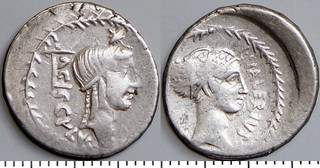
|
In the field of prosopographical problems connected with Republican moneyers, further important work has been done by BADIAN,27 MATTINGLY,28 MITCHELL,29 SUMNER30 and WISEMAN.31 Also, NICOLET's prosopographt of Equites of the Republican period is nearly ready for publication.
| (27) BADIAN, E., 'M. Calpurnius M.F. Piso Frugi", Acta Fifth International Congress of Greek and Latin Epigraphy, Cambridge 1967 (Oxford 1971) pp.209-214; BADIAN, E., 'Additional Notes on Roman Magistrates", Athenaeum 1970 pp.3-14. DOUGLAS, A.E., 'Cicero: Brutus', Oxford 1966; and MALCOVATI, E., 'Cicero: Brutus', Leipzig 1965, both reviewed by Badian, JRS 1967 pp.223-230. |
| (28) MATTINGLY, H.B., "Notes on some Roman Republican moneyers', NC 1969 pp.95-105. |
| (29) MITCHELL, J.F., 'The Torqati', Historia, Wiesbaden 1966, pp.23-31. |
| (30) SUMNER, G.V., 'The Lex Annalis under Caesar", Phoenix 1971 pp.246-271; Phoenix 1972 pp.357-371. |
| (31) WISEMAN, T.P., "T. Cloelius of Tarracina", CR 1967 pp.263-264; 'Two Friends of Clodius in Cicero's Letters', CQ 1968 pp.297-302; 'Two More Senators', CQ 1965 pp.158-160; 'Lucius Memmius and his Family", CQ 1967 pp.164-167; 'New Men in the Roman Senate 139 BC - AD 14', Oxford 1971. |
Survey 1966-71: Technical matters
Current interest in problems relating to the technology of ancient coinage has naturally extended to the Republican field. It is to be hoped that in the course of their investigations numismatists will not lose sight of the infinitely more important problems posed by the history of ancient technology as a whole; the most important study is that of FINLEY32 in 1965, which has been followed by those of PLEKET33 and REECE.34
| (32) FINLEY, M.I., 'Technical Innovation and Economic Progress in the Ancient World', EconHistRev 1965 pp.29-45. |
| (33) PLEKET, H.W., 'Technology and Society in the Graeco-Roman World', Acta Historiae Neederlandica, Leiden 1967 pp.1-25. |
| (34) REECE, G.W., 'The Technological Weakness of the Ancient World", G & R 1969 pp.32-47. |
Survey 1966-71: Types
Studies of individual issues and groups of issues have rightly continued to be recognised as a profitable approach; PAIRAULT35 has attempted to draw together the work done on Diana Nemorensis, who figures on the denarii of P. Accoleius Lariscolus; ALFÖLDI has completed his corpus of the denarii of 44 BC, though without so far providing any substantial commentary on the types; and NORTH37 has commented on Attis, sometimes thought to figure on the denarius of Cetegus. A rash article by FRIER38 on the coinage of Sulla provoked a prolonged controversy.39 Two articles by ROWLAND40 (with intervening comment by myself)41 fail in my view to provide any evidence for the thesis that Saturn was used at Rome as a coin type to express sympathy with Italian ideals.
| (35) PAIRAULT, F-H., 'Diana Nemorensis, Déesse latine, déesse hellénisée', Mélanges d'Archéologie at d'Histoire, Paris 1969 pp.425-471. |
| (37) LAMBRECHTS, P., 'Attis: van herdersknaap tot god', Brussels 1962, reviewed by J.A. North JRS 1965 pp.278-279. |
(38) FRIER, B., 'Augural Symbolism in Sulla's Invasion of 83', ANSMN 1967, pp.111-118.

|
| (39) BADIAN, E., 'Sulla's Augurate', Arethusa 1968 pp.26-46; FRIER, B., 'Sulla's Priesthood', Arethusa 1969 pp.187-199; BADIAN, E., 'A Reply', Arethusa 1969 pp.199-201. |
| (40) ROWLAND, R.J., 'Saturn, Saturninus and the Socii', ClassPhil 1967 pp.185-189; ROWLAND, R.J., 'The Italians and Saturninus', ClassPhil1 1969 pp.38-40. |
| (41) CRAWFORD, M.H., 'Saturninus and the Italians', ClassPhil 1969 pp.37-38. |
Survey 1966-71: Units of Reckoning
The Republican coinage is fraught with notorious problems involving the history of its units of reckoning. In this field HEURGON42 has studied the units used at Iguvium, related to the Roman; ZEHNACKER43 has discussed the quadrans ratitus of Lucilius; the dissertation of GAST44 is of the greatest importance, providing as it does corroborating evidence for the view that sums of money in Livy derive from official sources. GRAHAM45 has dealt with the origin of X as the mark of the figure 10.46
| (42) HEURGON, J., 'L'Ombre à l'époque des Gracches et de Sylla', Problemi di storia e archelogia dell'Umbra, Gubbio/Perugia 1966 pp.113-131. |
| (43) ZEHNACKER, H., 'Quadrans ratitus', Hommage à Marcel Renard Vol.3 (Latomus 103) Brussels 1969 pp.695-707. |
| (44) GAST, L., 'Die zensorischen Bauberichte bei Livius und die römischen Bauinschriften', dissertation Göttingen 1965. |
| (45) GRAHAM, J.W., "X = 10", Phoenix 1969 pp.346-358. |
Survey 1966-71: Artistic Considerations
The coinage of the Republic has perhaps been most fertile as a field of study for art historians. BABELON47 and CHAMOUX48 have worked on the portrait of Flamininus; JANTZEN,49 JOHANSEN,50 KIANG51 and SEYRIG52 on that of Caesar. General problems of portraiture are discussed by JONGKEES,53 though not to any great effect, and by HAFNER,54 who has also published a cult statue of Juno Sospita. Three pieces of work deserve special mention: BERTOLDI55 has published the celebrated triumphal reliefs from the Via del Mare;56 COARELLI57 has attempted to introduce some sanity into the discussion of the altar of Domitius Ahenobarbus and VOLLENWEIDER58 has continued to produce important work on late Republican gems. Her book collects and discusses a number of major artistic groups; the interest of the work is high, even if the links proposed between gem-engravers and die engravers turn out in the end to be much less close than she supposes.59
| (47) BABELON, J., L'effigie de Flamininus' ', RBN 1970 pp.59-63 [full article in linked page] |
| (48) CHAMOUX, F., 'Un portrait de Flamininus à Delphes', BCH 1965 pp.214-224. |
| (49) JANTZEN, U., 'Caesar Mattei', MDAA(R) 1968 pp.170-173. |
| (50) JOHANSEN, F.S., 'Antichi ritratti di Caio Giulio Cesare nella scultura', Analecta Romana Instituti Danici, Copenhagen 1967 pp.7-68. |
| (51) KIANG, D., 'Colonia Iulia Viennensium', SM May 1969 pp.33-36. |
| (52) SEYRIG, H., 'Un portrait de Jules César', RN 1969 pp.53-54. |
| (53) JONGKEES, J.H., 'Primitive imagines maiorum on Coins of the Roman Republic', AArch 1965 pp.233-239. |
| (54) HAFNER, G., 'Das Bildnis des Q. Ennius', Baden-Baden 1968; 'Cn. Naevius und M. Claudius Marcellus', MDAI(R) 1968 pp.64-73; 'Der Kultbildkopf einer Göttin im Vatikan', JAI 1966 pp.186-205. |
| (55) BERTOLDI, M.E., 'Un monumento commemorative sul Campidoglio', Quaderni Inst.Top.Ant. Rome 1968 pp.39-53. |
| (56) Note also H. KÄHLER's study of the monument of Aemilius Paullus, 'Der Fries vom Reiterdenkmal des Aemilius Paullus in Delphi', Berlin 1965. |
| (57) COARELLI, F., 'L'ara di Domizio Enobarbo e la cultura artistica in Roma del II secolo a.C.', DialArch 1968 pp.302-368. |
| (58) VOLLENWEIDERm M-L., 'Die Steinschneidekunst und ihre Künstler in spätrepublikanischer und augusteischer Zeit', Baden-Baden 1966, 148pp. 100pls. |
| (59) I am substantially in agreement with the opinions expressed in the review by P. Zazoff, Gnomon 1969 pp.198-200. ZEHNACKER's forthcoming book deals largely with monetary art during the Republic. |
Survey 1966-71: Imitative Issues
Finally, two recent Romanian discoveries must be discussed. Of the dies published by LUPU60 from Tilisca, at least one was made by being mechanically copied from an official Republican denarius; it follows that struck copies of Republican coins could be produced in Romania which were barely distinguishable from official issues.61 A recent article of POENARU-BORDEA and STIRBU62 published an even more disturbing discovery; a recent hoard contains several instances of up to three Republican denarii cast from the same mould, a mould itself mechanically copied from an official Republican denarius. The cast pieces are only with difficulty distinguishable from somewhat worn struck pieces.
| (60) LUPU, N. 'Aspekte des Münzumlaufs im vorrömischen Dakien', JNG 1967 pp.101-121. |
| (61) See my 'Roman Republican Coinage' p.562. This discussion reproduced in its entirety including a picture of the referenced mechanically copied type on my page on Plated Coins of the Roman Republic. |
| (62) POENARU-BORDEA, GH. and STIRBU, C., 'Le Trésor de deniers romains républicains et du commencement du principat découvert à Breaza', SCN 1971 pp.265-282. |
The enormous numbers of Republican denarii from Dacia, clearly present there before the Roman conquest, have long posed a major problem; it is now clear that many were made in Dacia itself. In the absence of small denominations, they can hardly have played a meaningful role in any kind of monetary economy; they are perhaps to be regarded as objects which were, for reasons which are still unclear, important status symbols of pre-Roman Dacia. The official Republican issues which travelled to Dacia perhaps did so in return for slaves.
Survey 1966-71: For Future Exploration
There seem to me to be three fields which offer particularly fruitful possibilities for exploration. In the first place, die-links between issues occur in the early denarius coinage, in all three metals. In my book Roman Republican Coinage a few examples have been noted, but a systematic search would both add to our knowledge of the chronology of the period and enhance our understanding of the working of the mint.
Studies of the die-structures of individual issues are also immensely valuable, not least because they provide a firm idea of the sizes of the different issues treated. More die-studies, to add precision to the picture which emerges, would greatly improve our understanding of the financial history of the Republic.63
| (63) KNAPOWSKI, R., 'Die Staatsrechnungen der r&oumml;mischen Republik in der Jahre 49-45 v.Chr.' Frankfurt-am-Main 1967, is a largely arbitrary compilation; see 'Roman Republican Coinage' p.633 note 2. [from RRC p.633 note 2 'The best attempt is that of T.Frank, ESAR i, passim ... on ancient accounts see G.E.M. de Ste Croix in A.C. Littleton and B.S. Yamey, Accounting, pp.14-74 esp. pp.45-46'] ELIE FALLU of the University of Quebec is preparing a major study of the subject. |
But the most important work now to be done as far as the Roman Republican coinage is concerned is to place the evidence it provides in association with all the other evidence relevant to the problems on which it bears. The use made by OGILVIE64 of numismatic evidence in his commentary on the first five books of Livy, by TAYLOR65 in her work on Roman assemblies and by CLASSEN66 in his study of Roman ideas about kingship are examples of what I have in mind. WEINSTOCK's67 Divus Julius provides perhaps the best indication of what can be achieved by the use of the Republican coinage as the historical source:68 fertile in ideas, scrupulous in its respect for evidence, it is a model of collaboration between numismatics and history.
| (64) OGILVIE, R.M., 'A commentary on Livy, Books 1-5', Oxford 1965. |
| (65) TAYLOR, L.R., 'Roman Voting Assemblies from the Hannibalic War to the Dictatorship of Caesar', Ann Arbor 1966, 175pp., illus., chart, maps. |
| (66) CLASSEN, C.J., 'Die Königszeit im Spiegel der Literatur der römischen Republik (Ein Beitrag zum Selbstverständnis der Römer)', Historia 1965 pp.385-403. |
| (67) WEINSTOCK, S., 'Divus Julius', Oxford 1971. |
| (68) The discussions by GESCHE, H., 'Die Vergottung Caesars', Kallmünz 1968 and WEISSMÜLLER N-W., 'Caesars Vorstellung von seiner Regierungsform, Idee und Wirklichkeit', dissertation, Münster 1969, are insubstantial. |
Survey 1966-71: Referenced Hoards
- Agrinion: note 21 and Appendix (Hersh)
- Belgium: note 6
- Breaza: note 62
- Corinth: note 22
- Lattes: note 17
- Padua: note 26
- Various Roman Republican: notes 4,6,19,20
- Spain: note 8
Appendix
[Other numismatic research in the 1966-71 period not specifically referenced in the Survey]
- ALFÖLDI, A., 'Les deniers de C. Valerius Flaccus frappés à Marseille et les dernières émissions de drachmes massaliotes', RN 1969 pp.55-61.
- ALFÖLDI, A., 'Die Erklärung des Names Caesar in den spätrömischen Kompendien, zu v.Ael.2,3-5', Antiquitas, Reihe 4, Beiträge zue Historia-Augusta-Forschung Vol.4 Bonn 1968 pp.9-18.
- ALFÖLDI, A., 'Die Herrschaft der Reiterei in Griechenland und Rom nach dem Sturz der Könige', Gestalt und Geschichte: Festschrift K. Schefoldm Bern 1967 pp.13-47.
- BADIAN, E., 'Roman Imperialism in the Late Republic', 2nd ed. Oxford 1968
- BÉRANGER, J., 'Der Genius populi Romani in der Kaiserpolitik', BonnerJb 1965 pp.72-87.
- BERNAREGGI, E., 'Nummi pelliculati; considerazioni sull-argento suberato della repubblica romana', RIN 1965 pp/5-31.
- BLANCK, H., 'Wiedererwendung alter Statuen als Ehredenkmäter bei Griechen und Römern', Rome 1969
- BOARDMAN, J., 'Engraved Gems: the Ionides Collection', London 1968, 116pp. illus.
- BRUNT, P.A., 'Italian Manpower 225 BC - AD 14', Oxford 1971.
- CAZZANIGA, I., 'Nota al testo di Plinio NH xxxiii,46', PP 1967 pp.366-367.
- CHITESCU, M., 'Copies et imitations des deniers romains républicains découvertes en Dacie', MEmAntiq 1971 pp.209-258 (on p.255, 11 lines up, read 'copies' for imitations').
- COMBÈS, R., 'Imperator: Recherches sur l'emploi et la signification du titre d'Imperator dans la Rome républicaine', Paris 1966.
- COPE, L.H., 'Roman Imperial Silver Coinage Alloy Standards: the Evidence', NC 1967 pp.107-131.
- CRAWFORD, M.H., 'C Censorini', NC 1971 pp.143-149.
- CRAWFORD, M.H., 'The Edict of M. Marius Gratidianus', ProcCambridge PhilSoc 1968 pp.1-4.
- CRAWFORD, M.H., 'The Financial Organization of Republican Spain', NC 1969 pp.79-93.
- CRAWFORD, M.H., 'Money and Exchange in the Roman World', JRS 1970 pp.40-48.
- CRAWFORD, M.H., 'Plated Coins - False Coins' [Reproduced in full at the linked page]
- CRAWFORD, M.H., ''A Roman Representation of χεραμος Τρωιχος'. JRS 1971 pp.153-154.
- DUMÉZIL, G., 'La religion romaine archaique, suivi d'un appendice sur la religion des Étrusques', Paris 1966.
- ERCOLANI, E.C., 'Iconografia di Veiove sulla moneta romana rpeubblicana', RIN 1968 pp.115-130.
- FUCHS, G., 'Architekturdarstellungen auf römischen Münzen der Republik und der frühen Kaiserzeit', Berlin 1969, 138pp. 20pls. diagrams.
- GAGÉ, J., 'Le dieu "inventor" et les Minucii', Mélanges d'Archéoligie et d'Histoire', Rome 1966 pp.79-122.
- GALINKSY, G.K., 'Aeneas, Sicily and Rome', Princeton 1969.
- GELZER, M., 'Caesar: Politician and Statesman', Oxford 1958.
- GESCHE, H., 'Die Reiterstatuen der Aemilier und Marcier', JNG 1968 pp.25-42.
- GODDARD, P.J., 'The Edict of Marius Gratidianus and the Coinage of the Marians', SCMB Jan. 1969 pp.7-11; Feb. 1969 pp.42-43.
- de GUADAN, A.M., 'Numismatica Iberica e Ibero-romana', Madrid 1969, 288pp. illus. maps.
- HENIG, M., 'The Veneration of Heroes in the Roman Army, the Evidence of Engraved Gemstones', Britannia 1970, pp.249-265.
- HERSH, C.A., 'The Agrinion Find and the Problem of the Chronology of the Roman Republican Coinage during the Second Century BC', NC 1966 pp.337-346.
- HUZAR, E.G., 'Egyptian Influences on Roman Coinage in the Third Century BC', CJ 1965-1966 pp.337-346.
- KAPOSSY, B., 'Marsyas und die Politik der Populares', SIM Aug.1965 pp.74-79.
- KLAFFENBACH, G., 'Eine neue Ehrenstatue für T. Quinctius Flamininus', Chiron 1971 pp.167-168.
- KRAFT, K., 'Taten des Pompeius auf den Münzen', JNG 1968 pp.7-24.
- LAZZARINI, M., 'Metrologia romana', Conimbriga, Coimbra 1965, pp.81-95.
- LUCE, T.J., 'Political Propoganda on Roman Republican Coins: ca. 92-82 BC', AJA Jan. 1968 pp.25-39.
- MAGDELAIN, A., 'Recherches sur l'imperium: La loi curiate et les auspices d'investiture', Paris 1968.
- MASQUELIER, N., 'Pénates et Dioscures', Latomus 1966 pp.88-98.
- MATTINGLY H.B., 'New Light on the Roman Victoriate', Essays Robinson, pp.210-228.
- MATTINGLY H.B., 'Saturninus' Corn Bill and the Circumstances for his Fall', CR 1969 pp.267-270.
- MAYER, E., 'Das Sauprodigium und sein religiongeschichtlicher Hintergrund', AAntiquaAcadSciHung 1968 pp.198-208.
- MICHEL, D., 'Alexander als Vorbild für Pompeius, Caesar und Marcus Antonius; archäologische Untersuchungen', Latomus 94, Brussels 1967.
- MOMIGLIANO, A.D., 'Quarto contributo alla storia degli studi classici e del mondao antico', Rome 1969.
- MOMIGLIANO, A.D., 'Terzo contributo alla storia degli studi classici e del mondao antico', Rome 1966.
- MORONI, G., 'Appunti su alcune monete di Capua', RIN 1968 pp.97-113.
- NICOLET, Cl. 'L'ordre équestre à républicaine, 312-43 av. J.C., Vol.1', Paris 1966.
- OGILVIE, R.M., 'Some Cults of Early Rome', Hommages à Marcel Renard Vol.2, Latomus 102, Brussels 1969 pp.566-572.
- RAWSON, B., 'Pompey and Hercules', Antichthon 1970 pp.30-37.
- RICHTER, G.M., 'Gems of the Romans', London 1971.
- ROWLAND, R.J., 'Numismatic Propoganda under Cinna', TAPhA 1966 pp.407-419.
- SCULLARD, H.H., 'Scipio Africanus: Soldier and Politician', London 1970.
- SERAFIN, P.P., 'Nota sull'argento suberato della repubblica romana', AIIN 1968 pp.9-28.
- TOYNBEE, J.M.C., 'The Art of the Romans', London 1965.
- VOLLENWEIDER, M-L., 'Un épisode de la vie du général Pompée le Grand', Hommages à Marcel Renard Vol.3, Latomus 103, Brussels 1969 pp.655-661.
- WALBANK, F.W., 'The Scipionic Legend', ProcCambridgePhilSoc 1967 pp.54-69.
- WARREN, L. BONAFANTE, 'Roman Triumphs and Etruscan Kings: the Changing Face of the Triumph', JRS 1970 pp.49-66.
- WINKES, R., 'Clipeata imago: Studien zu einer römischen Bildnisform', Bonn 1969.
- Introduction: Surveys, The Roman Republic, 1966-1977; Notes to Edinburgh
- A Survey of Numismatic Research 1972-1977, The Roman Republic, by Michael H. Crawford
- A Survey of Numismatic Research 1966-1971, The Roman Republic, by Michael H. Crawford
- Notes to the Edinburgh Collection, by Michael H. Crawford
- A Survey of Numismatic Research 2002-2007, The Roman Republic, by Bernhard Woytek
Michael Crawford, notes to the Edinburgh collection.
A Catalogue of the Roman Republican Coins in the collection of the Royal Scottish Museum Edinburgh, Michael Crawford, 1984
Highly important, not because of the coins, but because it was written by Michael Crawford and he
took the opportunity to comment on updated typology research since the
publication of RRC in 1974. It is a rare book, so I've extracted many of Crawford’s
comments on typology research.
[Square bracketed italic text is my synthesis of Crawford's RRC thesis,
or extra context where needed],
non-bracketed regular text is from the Edinburgh catalogue.
These scattered fragments may seem terribly out of context, as indeed they are because they assume you have access to wider and
deeper learning.
I have sought additional context for my own understanding of these notes, and shared this where I can.





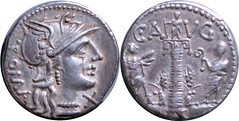















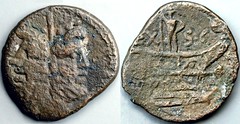











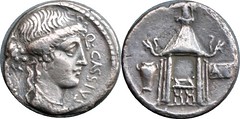






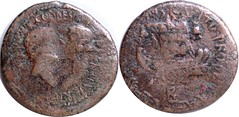



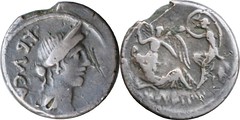

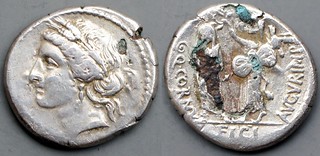





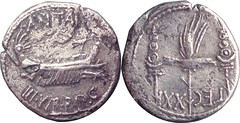
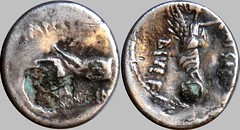
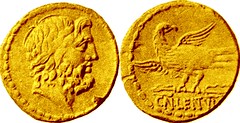
- Introduction: Surveys, The Roman Republic, 1966-1977; Notes to Edinburgh
- A Survey of Numismatic Research 1972-1977, The Roman Republic, by Michael H. Crawford
- A Survey of Numismatic Research 1966-1971, The Roman Republic, by Michael H. Crawford
- Notes to the Edinburgh Collection, by Michael H. Crawford
- A Survey of Numismatic Research 2002-2007, The Roman Republic, by Bernhard Woytek
All content copyright © 2004-2011 Andrew McCabe unless otherwise noted. If you've any questions or comments please contact me on the Yahoo Group RROME: http://groups.yahoo.com/group/RROME.
Alternately you can leave comments against any coin picture, just click on the picture and write in the comment box.
See my rarity estimates for Roman Republican Bronzes: Roman Republic Bronze Rarities..










